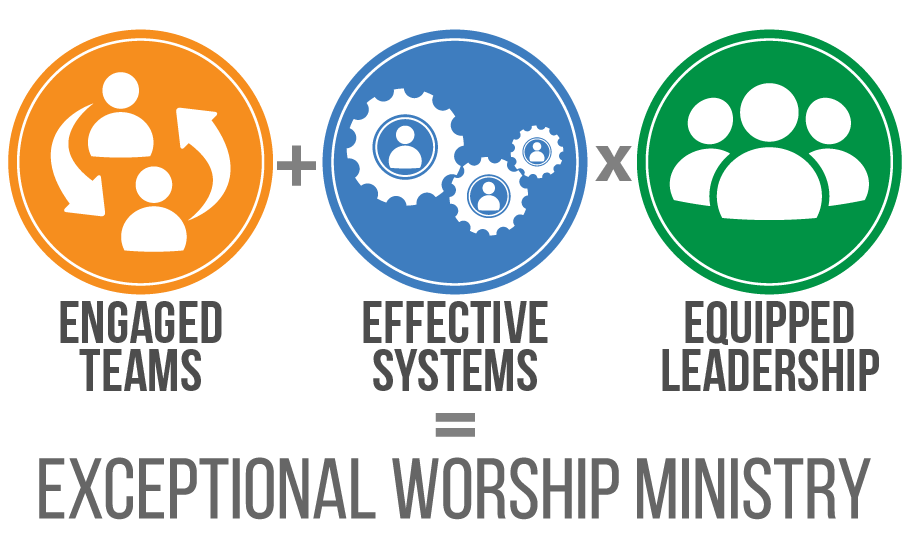Do you have some worship team members who are…
Uncommitted to your worship ministry?
Unprepared with their music?
Unspiritual—that is, they just don’t seem to deep?
Unconcerned for other team members?
Unconnected with your church?
Unreceptive to your leadership?
Unavailable when you need them?
Unresponsive to your scheduling requests?
Un-on-time…all the time?
Now, you might have one or two team members who fall in every category. (They’re called “complete-slackers-that-my-predecessor-invited-on-the-team-and-now-I-can’t-get-rid-of-them.”)
But likely, you have a lot of team members who display a just few these unhealthy traits. But even the presence of a couple of those unhealthy traits makes them a less-than-productive team member. And putting a few of them together makes for an unhealthy team.
Here at worship team coach, when we talk about healthy team members, we describe them as ENGAGED.
In fact, that is a crucial part of the process of helping you grow a strong worship ministry:

As Jerimae Yoder (my Director of Coaching) and I work with worship teams (in our own churches and in others), we’ve drilled down to identify seven areas where your team members need to be “engaged.”
If your team members are engaged and growing in each of these areas, you will have the foundation of a healthy team.
So that’s what we’re going to look at in this 3-part blog post: what does an engaged team member really look like?
But let's talk about that word first: engage.
It’s a rich word. In various forms, it can be a verb or an adjective. Between those different forms, the dictionary has upwards of fifteen different definitions.
So as we’re describing what an “engaged team” looks like, we’ll be pulling from those definitions and various forms of the word.
The first area of engagement is the most important one:
1. ENGAGE WITH GOD
At the heart of what we worship leaders are about is this: Leading people to worship God, through Christ, in the power of the Holy Spirit.
We can draw from two definitions of engage here to clarify this:
To occupy oneself; become involved.
When we occupy ourselves with Christ, we begin to have another form of engaging.
To attract and hold fast.
If you think about it, it's truly God who engages us. We simply need to trust James 4:8, “Come close to God, and God will come close to you.”
The more we do this, the less our hearts are “divided between God and the world” (as James goes on to say in that verse).
Healthy Looking
If your team members don’t have a growing relationship with God, then all the other levels of engagement are in vain. You can build a “healthy looking” worship ministry by concentrating on those other levels.
And I believe God can still work through that team to bless and encourage people in the congregation who are worshiping him.
But how much more could a team accomplish if they are truly seeking to engage themselves with God, and be engaged by Him?
The second area of engagement is this:
2. ENGAGE WITH LEADERSHIP
Leadership is the core of great teams. There are a couple of definitions of engagement here. The first is this:
To bind, as by pledge, promise, contract, or oath.
There’s a promise (spoken or unspoken) that each of us makes when we join any team: I am committing to this team’s leadership.
Romans 13 and Hebrews 13 both give us instructions on following those leaders above us.
The first part of Romans 13 tells us that all authority comes from God. He has delegated it.
Everyone must submit to governing authorities. For all authority comes from God, and those in positions of authority have been placed there by God.
Romans 13:1 (NLT)
And the instructions from the writer of Hebrew is focused specifically on spiritual leaders:
Obey your spiritual leaders, and do what they say. Their work is to watch over your souls, and they are accountable to God.
Hebrews 13:17 (NLT)
As a worship leader, director, or pastor, you certainly fall into this role of authority.
But remember, you are called to lead like Jesus: with strength from the authority that you’ve been given, AND also serving them humbly and with compassionate love.
Now, we don’t have time in this post to talk at length about how to deal with insubordinate or disrespectful team members. Here’s an article that might help. It talks about how to handle slackers, but many of the principles are the same.
And remember, the insubordination or lack of respect for you as a leader is probably (like 99.9%) a symptom of a deeper issue in their heart that has nothing to do with you.
FIGHT MUCH?
There’s another form of engage that is at play here for the leader and the team member, and that’s this:
To enter into conflict with.
Whoa, wait, we just looked at following and submitting to leaders, now we’re talking about fighting?
Yes. Healthy teams embrace conflict.
We as leaders need to foster healthy, ideological conflict. That is, conflict based on ideas and concepts, not tearing down another person’s character.
We’re going to have conflict. There’s no escaping that. We have imperfect team members, so we’re going to need to confront issues with them.
And we’re imperfect—our team members will need to confront us. So we all need to learn to engage in healthy conflict. Not only do our team members need to have healthy engagement with their leaders, but they need to have healthy engagement with their teammates.
That’s the next area of engagement−which we’ll talk about in Part Two.

Want your team members to grasp these 7 Ways To Engage?
We've got a training series & team member assessment available for FREE. Email matt@worshipteamcoach.com to receive your training kit.
Stuck?
Learn how to level-up your team with this free video training.







